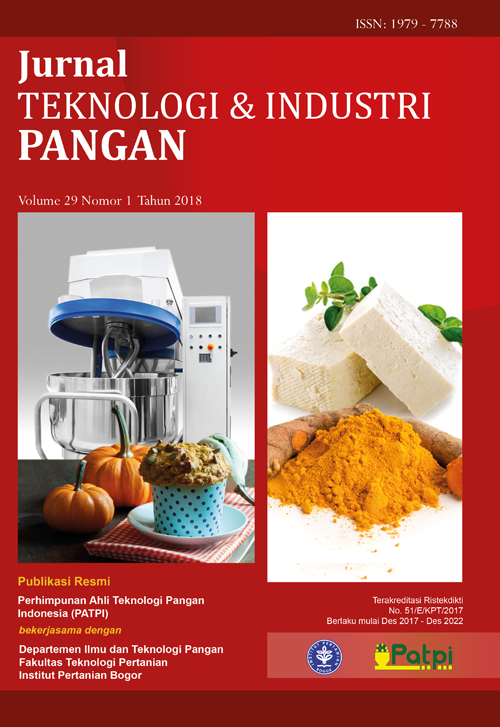KARAKTERISTIK FISIK TEPUNG TEH HIJAU YANG DIPROSES MENGGUNAKAN MESIN DISC MILL DAN STONE MILL
Abstract
References
Barbosa-Canovas GV, Ortega-Rivas E, Juliano P, Yan H. 2005. Food Powders: Physical Proper-Ties, Processing, and Functionality. 19-88. Food Engineering Series. 1st Edition. XVI 372. Springer US Publishers. New York City, USA. DOI: 10.1007/0-387-27613-0.
Braicu C. Ladomery MR, Chedea VS, Irimie A, Berindan-Neagoe I. 2013. The relationship bet-ween the structure and biological actions of green tea catechins. Food Chem 141: 3282–3289. DOI: 10.1016/j.foodchem.2013.05.122.
Cuevas-Rodrı́guez EO, MiIán-Carrillo J, Mora-Esco-bedo R, Cárdenas-Valenzuela OG, Reyes-Mo-reno C. 2004. Quality protein maize (Zea mays L.) tempeh flour through solid state fermenta-tion process. LWT-Food Sci Tech 37: 59-67. DOI: 10.1016/S0023-6438(03)00134-8.
de Oliveira A, Prince D, Lo C.-Y, Lee LH, Chu T.-C. 2015. Antiviral activity of theaflavin digallate against herpes simplex virus type 1. Antivir Res 118: 56–67. DOI: 10.1016/j.antiviral.2015.03.0 09.
Fitzpatrick J. 2013. 12 - Powder properties in food production systems. di dalam buku Handbook of food powders processes and properties. 285–308. Woodhead Publishing Cambridge, UK. DOI: 10.1533/9780857098672.2.285.
Fujioka K, Iwamoto T, Shima H, Tomaru K, Saito H, Ohtsuka M., Yoshidome, Kawamura Y, Mano-me Y. 2016. The powdering process with a set of ceramic mills for green tea promoted cate-chin extraction and the ROS inhibition effect. Molecules 21: 1-12. DOI: 10.3390/molecules21 040474.
Hajiaghaalipour F, Kanthimathi MS, Sanusi J, Rajarajeswaran J. 2015. White tea (Camellia sinensis) inhibits proliferation of the colon can-cer cell line, HT-29, activates caspases and protects DNA of normal cells against oxidative damage. Food Chem 169: 401–10. DOI: 10.101 6/j.foodchem.2014.07.005.
Haraguchi Y, Imada Y, Sawamura S. 2003. Produc-tion and characterization of fine Matcha for pro-cessed food. J Jpn Soc Food Sci 50: 468–473. DOI: 10.3136/nskkk.50.468.
Henning SM, Yang J, Hsu M, Lee R.-P, Grojean EM, Ly A, Tseng C-H, Heber D, Li, Z. 2017. De-caffeinated green and black tea polyphenols decrease weight gain and alter microbiome po-pulations and function in diet-induced obese mice. Eur J Nutr: 1–11. DOI: 10.1007/s0039401 7-1542-8.
Hirai M, Yoshikoshi H, Kitano M, Wakimizu K, Sakaida T, Yoshioka T, Nitabaru J, Nakazono K, Hayashi M, Maki, T. 2008. Production of value-added crop of green tea in summer under the shade screen net: Canopy microenviron-ments. Acta Hortic 797: 411–418. DOI: 10.1766 0/ActaHortic.2008.797.59.
Hu J, Chen Y, Ni D. 2012. Effect of superfine grin-ding on quality and antioxidant property of fine green tea powders. LWT-Food Sci Technol 45: 8–12. DOI: 10.1016/j.lwt.2011.08.002.
Kavaz-Yüksel A, Yüksel M, Şat İG. 2017. Deter-mination of certain physicochemical charac-teristics and sensory properties of green tea powder (matcha) added ice creams and detec-tion of their organic acid and mineral contents. Gida/ the J of Food 42: 116–126. DOI: 10.1523 7/gida.GD16072.
Komes D, Horzic D, Belscak A. Ganic KK, Vulic I. 2010. Green tea preparation and its influence on the content of bioactive compounds. Food Res Int 43: 167–76. DOI: 10.1016/j.foodres.200 9.09.022.
Lumay G, Boschini F, Traina K, Bontempi S, Remy JC, Cloot R, Vandewalle N. 2012. Measuring the flowing properties of powders and grains. Powder Technol 224: 19–27. DOI: 10.1016/j.po wtec.2012.02.015.
Murtini ES, Prawira-Atmaja MI, Sutrisno A. 2016. Sorghum flour characteristics as affected by solid state and submerged fermentation me-thods. J Teknol dan Industri Pangan 27: 59–67. DOI: 10.6066/jtip.2016.27.1.59.
Ning JM, Hou GG, Sun JJ, Wan, XC, Dubat A. 2017. Effect of green tea powder on the quality attri-butes and antioxidant activity of whole-wheat flour pan bread. LWT-Food Sci Technol 79: 342–48. DOI: 10.1016/j.lwt.2017.01.052.
Pandey RK, Manimehalai N. 2014. Production of instant tea powder by spray drying. Int J Agr and Food Sci Technol 5: 197–202.
Park D, Imm J, Ku K. 2001. Improved dispersibility of green tea powder by microparticulation and formulation. J Food Sci 66: 793–798. DOI: 10.1 111/j.1365-2621.2001.tb15174.x.
Pasrija D, Ezhilarasi PN, Indrani D, Anandharama-krishnan C. 2015. Microencapsulation of green tea polyphenols and its effect on incorporated bread quality. LWT-Food Sci Technol 64: 289–96. DOI: 10.1016/J.LWT.2015.05.054.
Ramachandraiah K, Chin KB. 2016. Evaluation of ball-milling time on the physicochemical and antioxidant properties of persimmon by-pro-ducts powder. Innov Food Sci Emerg 37: 115–124. DOI: 10.1016/j.ifset.2016.08.005.
Rohdiana D, Suganda AG, Wirasutisna KR, Iwo MI. 2014. Xanthine oxidase inhibitory and immuno-modulatory activities of fifteen grades Indonesia orthodox black tea. Int J Pharm Pharm Sci 6: 39–42.
Sakurai Y, Mise R, Kimura S, Noguchi S, Iwao Y, Itai S. 2017. Novel method for improving the water dispersibility and flowability of fine green tea powder using a fluidized bed granulator. J Food Eng 206: 118–124. DOI: 10.1016/j.jfoodeng.201 7.03.010.
Sawamura S, Ichitani M, Ikeda H, Sonoda J. 2012. Foaming property and foam diameter of matcha varies with particle size. J Jpn Soc Food Sci 59: 109–14. DOI:10.3136/nskkk.59.109.
Schuck P, Anne D, Jeantet R. 2012. Analytical Methods for Food and Dairy Powder. 119-189. A john Wiley & Sons, Ltd., Publication. West Sussex, UK. DOI: 10.1017/CBO978110741532 4.004.
Sharangi AB, Siddiqui W, Dávila Aviña JE. 2014. Black tea magic: overview of global research on human health and therapeutic potentialities. J Tea Sci Res 4: 1–16. DOI: 10.5376/jtsr.2014.0 4.0001.
Topuz A, Dinçer C, Torun M, Tontul I, Şahin-Nadeem H, Haznedar A, Özdemir F. 2014. Phy-sicochemical properties of Turkish green tea
powder: Effects of shooting period, shading, and clone. Turk J Agric For 38: 233–241. DOI: 10.3906/tar-1307-17.
Zhang Z, Song H, Peng Z, Luo Q, Ming J, Zhao G. 2012. Characterization of stipe and cap pow-ders of mushroom (Lentinus edodes) prepared by different grinding methods. J Food Eng 109: 406–413. DOI: 10.1016/j.jfoodeng.2011.11.007.
Zokti J, Sham Baharin B, Mohammed A, Abas F. 2016. Green tea leaves extract: microencap-sulation, physicochemical and storage stability study. Molecules 21: 940. DOI: 10.3390/molecu les21080940.
Xiao W, Zhang Y, Fan C, Han L. 2017. A method for producing superfine black tea powder with en-hanced infusion and dispersion property. Food Chem 214: 242–247. DOI: 10.1016/j.foodchem. 2016.07.096

